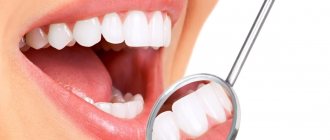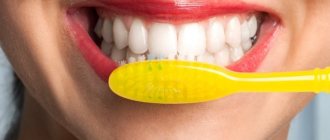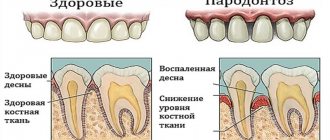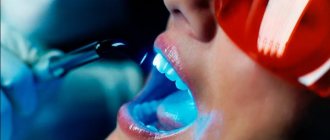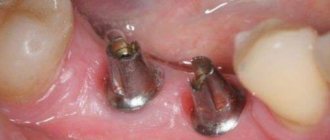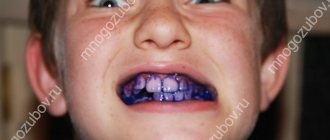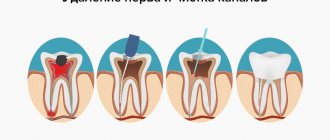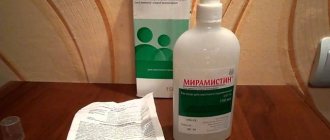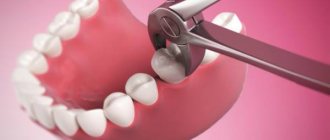Features of professional teeth cleaning
Modern methods for removing tartar are a safe and comfortable procedure. It can be performed on absolutely every patient and even pregnant women.
The exception is a violation of the integrity of the enamel and increased sensitivity of the hard tissues of the teeth. Today, ultrasound is most often used for this.
The advanced technologies used help minimize pain and further negative consequences.
Treatment of teeth using an ultrasonic scaler
Carrying out the removal of tartar using ultrasonic units has several stages, which the doctor performs in a certain sequence:
- Pain relief . It is carried out as necessary. To achieve the desired effect, use application or, in extreme cases, infiltration anesthesia. The indication for pain relief is increased sensitivity of the soft and hard tissues of the patient’s oral cavity.
- Stone removal . This stage is the main one in professional teeth cleaning. Under the influence of ultrasound, tartar is destroyed and easily moves away from the enamel surface. The supplied stream of water helps remove even the smallest particles from the surface of the teeth.
- Using the Air Flow device . Quite often, this procedure is considered completely separately and has nothing to do with ultrasonic teeth cleaning. But with professional oral care, dentists use techniques to achieve the best results. The peculiarity of the procedure is that, under pressure, abrasive particles with a stream of water rush to the surface of the tooth from a special apparatus. They help remove remaining pigmentation, which can persist even from ultrasound. Thus, partial whitening of the enamel is ensured, and it becomes 1-2 shades brighter.
- Polishing of hard tooth tissues . In all cases, after the procedure, the enamel surface has a certain roughness. This condition will further ensure the rapid accumulation of plaque and the formation of new tartar. To prevent this from happening, the treated crown is polished using special rubber discs, brushes and other devices. The smooth surface will provide a natural shine to the enamel and protect the teeth from the negative factors of the oral cavity.
- Antiseptic treatment . It is mandatory, since the gums can be damaged during the procedure. In addition, usually due to dental plaque, periodontal tissues are partially inflamed, and the use of antiseptics will avoid additional complications and the spread of infection.
- Fluoridation of teeth . This stage of treatment is necessary for certain indications. For example, if the enamel is prone to destruction, is weak, or has increased sensitivity, then the use of fluoride-containing preparations will strengthen it.
- Use of medicinal dressings . They are necessary for severe periodontal inflammation, bleeding or significant trauma that occurred during the removal of dental plaque. The dressings are prepared immediately before use. Depending on the indications, they contain antibiotics, sulfonamides, antiviral drugs, fungistatic agents, as well as antiseptics and enzymes.
In the photo, removing tartar using the Air Flow method
You can learn how dental plaque is removed using ultrasound by watching the video in this article.
How to get rid of discomfort after cleaning?
Discomfort due to the procedure is normal, since a thin layer of tooth enamel is removed along with plaque and tartar. But for some people, teeth and gums are not just uncomfortable, but painful.
- If the pain does not go away within 24 hours, you need to make an appointment with the dentist and take painkillers.
- You can relieve pain using applications with anti-inflammatory drugs, for example, Metrogyl-Denta. They are designed to relieve inflammation and swelling.
- You can get rid of discomfort with proper dental care and nutrition. It is important to exclude hot, cold, sour, etc.
- After the first 24 hours, it is advisable to brush your teeth with a soft bristle brush after eating.
Toothache, even of low intensity, causes a lot of inconvenience. At home, it is impossible to eliminate the causes of its occurrence; you can only temporarily numb the aching tooth or gum, and then visit the dentist. However, pain may appear precisely after visiting a doctor and having your mouth professionally cleaned. What to do in this case? We suggest you look into this issue.
Causes of gum pain after stone removal
Unpleasant sensations almost always occur after certain dental procedures. All the reasons why periodontal pain appears are associated with two groups of factors.
The first is individual increased sensitivity of hard and soft tissues of the oral cavity. The second is associated with various gum diseases, such as gingivitis, periodontitis, periodontal disease, histiocytosis and other pathologies.
Tartar itself can cause these problems. It is because of this that most diseases develop in the periodontium.
Bleeding gums, the most common complication after stone removal
Medical intervention provokes some exacerbation of the pathology, and the symptoms thereby intensify. But if you follow all the dentist’s recommendations, the discomfort will subside within a few days.
The instructions received from the doctor for the rehabilitation period must be followed without fail. This will ensure a speedy recovery and help prevent complications.
In addition, the following may be the reasons for discomfort after professional teeth cleaning:
- enamel microcracks;
- incorrectly selected toothpaste;
- cariogenic damage;
- inflammatory process in the gums;
- damage to the mucous membrane;
- soft tissue injuries;
- pulpitis or periodontitis of the tooth;
- The toothbrush is too hard.
Tartar as a cause of gum inflammation and pain
Regular brushing of teeth, which is carried out by all people twice a day, is not capable, even with full compliance with the rules of its implementation and the use of high-quality brushes, to completely rid a person of plaque that constantly forms in the oral cavity. Most often, its accumulation occurs in the space between individual teeth. This applies primarily to the posterior space, cervical area and subgingival space.
Over time, mineral compounds begin to accumulate in plaque. They further lead to compaction of deposits. The longer this process takes place, the stronger the stone is formed. It will be impossible to get rid of it on your own.
Inflamed gums due to tartar
Over time, dense stones lead to an inflammatory process
.
This consequence is called gingivitis
.
Pathological periodontal pockets appear, as well as periodontal disease
- deep damage to the periodontal tissue. Currently, this pathology is called periodontitis with an aggressive course.
Rules of conduct for the period of rehabilitation
After the doctor carries out professional teeth cleaning, you need to follow certain recommendations for about a week. Correct behavior will allow you to maintain the positive result obtained for a long time and prevent the development of additional pathologies.
The main recommendations after performing the manipulation are:
- Two or three times a day, especially after meals, be sure to rinse your mouth with a disinfectant solution. The best results are obtained with a drug such as Chlorhexidine. However, one side effect has been noticed. With long-term use, after using Chlorhexidine, a gray coating remains on the surface of the enamel and mucous membrane. In this case, you can use its analogue, Miramistin solution. These drugs cannot be used for more than 5 days, as they can suppress the entire microflora, which leads to local dysbiosis.
- If bleeding occurs, it is recommended to use applications of special ointments and gels. Metrogyl Denta gel is excellent for these purposes. It must be applied immediately after meals 2-3 times a day, using a cotton swab for 20 minutes. The therapeutic course should be 3-5 days. If after some time there is no result, then Metrogyl-Dent must be replaced with another drug.
- To accelerate the regeneration of periodontal tissue, use Solcoseryl paste or Paradontax. These drugs will help not only epithelize damaged periodontal tissue, but also strengthen the gums for a long time.
- To maintain the results obtained, it is necessary to use additional oral care products, such as dental floss, rinses, the use of an irrigator and the selection of highly effective toothpastes.
Reliable and effective antiseptic for treating gums
Dentists usually give such recommendations when certain problems arise in the periodontal tissues, both before professional teeth cleaning and after removing tartar.
If discomfort in the oral cavity is associated specifically with this procedure, then the following rules will help reduce negative phenomena:
- immediately after the procedure, you must refrain from consuming hot and too cold drinks, as well as similar foods, for 2-3 hours;
- Do not eat rough foods for 24 hours;
- for 12 hours, exclude drinks that can stain the enamel; wine, coffee, natural juices from citrus fruits;
- it is necessary to replace the old toothbrush with a new one, which should then be used for no more than 3 months;
- use the oral care products recommended by the dentist;
- It is necessary to visit the clinic every 3-4 months and have your teeth professionally cleaned;
- If there is severe pain after the procedure, it is better not to brush your teeth for at least 12 hours.
Is it worth enduring severe pain?
Painkillers in tablets
If your gums hurt after tartar removal within 24 hours, and there is no decrease in discomfort, then they may be caused by any complications associated with the procedure.
If you have a severe pain attack, you can take the following medications before visiting the dentist:
- Analgin;
- Ketorol;
- Nurofen;
- Pentalgin;
- Ketanov.
The problem can also be eliminated using folk remedies. It should be remembered that this type of effect has only a temporary effect. If the problem is associated with the occurrence of an inflammatory process, then only a doctor can eliminate the pain reaction.
Teeth sensitivity after whitening and ultrasonic cleaning
Tooth sensitivity means its excessive reaction to one or another sensory stimulus, which can be either temperature (cold or hot) or food. This phenomenon, if left untreated, leads to chronic consequences.
The occurrence of sensitivity after the removal of tartar is due to the fact that mineral accumulations, despite their adverse effects, still to a certain extent protect the enamel from chemical, thermal and tactile irritants.
In some cases, the process of brushing teeth using certain methods leads to damage to the top protective layer. In such a situation, coping with the complication that has arisen will not be easy.
What to do if you have gum inflammation and toothache after brushing?
This article talks about typical ways to solve your issues, but each case is unique! If you want to find out from me how to solve your particular problem, ask your question. It's fast and free
!
When the cause of toothache and inflammation of the gums is known, you can try to prevent it. The question arises: what measures should be taken if, despite all precautions, pain still occurs? How to cope with painful sensations before contacting a specialist and what methods will the dentist treat pain?
Drug therapy
If your teeth are sensitive, your dentist will apply local anesthesia before the cleaning procedure. It will work for some time after the tartar is removed. If your gums and teeth hurt, you don’t need to endure the pain (see also:). Painkillers will help relieve pain:
- Ketanov;
- Ketalong;
- Ketoral;
- Pentalgin;
- Nurofen.
In addition to tablets, you can use applicators with antibacterial and anti-inflammatory agents, which will not only relieve pain, but also relieve swelling of the gums: Metrogyl-Denta, Traumeel S and others.
For daily hygiene procedures during this period, it is better to take fluoride-containing toothpaste. Various mouth rinses with medicinal herbs will also help relieve discomfort. They relieve inflammation, have a calming effect and reduce swelling of soft tissues.
Folk remedies
To eliminate toothache and gum sensitivity, you can use folk remedies. Decoctions of medicinal herbs are very effective. They relieve irritation, soothe, and relieve pain. Several recipes for home use:
If after using folk remedies the pain does not subside or home treatment brings only short-term relief, then you should consult a dentist. Only a doctor can determine the true cause of long-term pain and prescribe the correct treatment.
